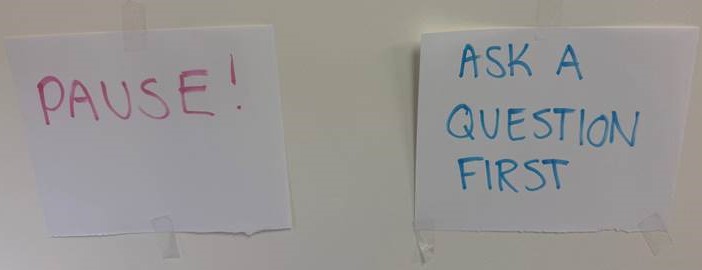Learning to Pause
by Jessica Kunstman
Today’s Tuesday Reading is from Jessica Kunstman, Director, Organizational Change at Yale University OPMO and a MOR program participant. Jessica may be reached at [email protected] or via LinkedIn.
At the start of my MOR leadership journey, I set one big goal: to improve how I communicate so that I could better meet the needs of those I work with. I quickly realized this isn’t a quick fix—it’s a long-term shift in how I think and act. Honestly? It’s hard. And tiring.
That’s why my most recent workshop felt so helpful. The conversations, tools, and examples we explored pushed me in the right direction. This goal of mine—being a more adaptive and intentional communicator—will be a lifelong effort. And let’s be real: it’s tough to slow down when life feels like it’s moving at lightning speed. Between work, an always-on culture full of nonstop information and messages, a generally high energy personality, and two little kids calling “Mom! Mom! Mom!” before and after work (seriously, have you seen that viral video where a mom counted how many times her one kid said “mum” in a day—234 times?!), it can feel like I’m on a constant roller coaster.
And in that chaos, it’s easy to lose the ability to truly connect—with coworkers, with teams, and sometimes even with myself. One of the biggest lessons I’m taking with me from MOR is the power of learning to pause. It sounds simple—but it’s not easy.
Why Learning to Pause Matters
We learned that pausing is an intentional leadership act. Whether it’s before responding to a hard question, making a big decision, or entering a difficult conversation, pausing gives us time to think, breathe, and realign.
Here’s what pausing can do:
- In communication: A pause helps us listen fully, instead of rushing to respond.
- In conflict: A pause can calm things down and create space for empathy.
- In leadership: A pause shows maturity—it tells people we’re not making decisions on impulse.
- In relationship building: slowing down enough allows us to really see each other and understand each other’s needs.
What I’ve Learned From Leaders I Admire
Looking at the leadership team at my institution, the people who really make a difference aren’t always the fastest talkers. They’re the ones who:
- Ask thoughtful questions like “What’s really going on here?”
- Say things like “Tell me more” instead of jumping to conclusions
- Wait until the end of a meeting before sharing really insightful feedback
- Recognize others and build connection before jumping into the agenda
I’m trying to follow their lead. It’s a work in progress, but here are a few things I’ve started doing:
How I’m Practicing the Pause
- Visual Reminders
I returned from the recent workshop and taped two notes on my wall—just simple reminders to slow down and be present. - Active Listening
I’m practicing not filling every silence. It’s uncomfortable! Just yesterday, I led a meeting with a struggling project team. I wanted to jump in and rescue the conversation. Instead, I let the silence sit. It was hard—and afterwards, a trusted colleague told me he could see me “squirming in my seat”. Baby steps…. - Delaying My Response
If I get a tough message or feel triggered in a meeting, I try to take a step back and wait before I react. It doesn’t mean I can’t feel what I feel, but perhaps “let it go” might be the better solution. - Check In, Not Just Check Boxes
I’m working on asking more thoughtful, curious questions—not just the ones that keep a project moving.
Final Thought
For me, learning to pause is a real shift. It’s not flashy. It takes work. But it’s one of the most powerful leadership tools I’ve found. Because when we slow down, we don’t just think better—we connect better. And at the end of the day, relationships are what make things work—in business, in leadership, and in life.

How could you best “practice the pause” in the coming week?
Understanding population demographics:
- 53% said not enough
- 31% said the right amount
- 16% said too much

Most of us feel we are not investing enough in understanding changing demographics. While last week’s article provided a great primer, the big follow-up questions are “so what?” and “now what?” Understanding the implications, determining a desired future state, and charting the course of action to get there is the essence of strategic thinking.
- October 2025 (3)
- September 2025 (5)
- August 2025 (7)
- July 2025 (5)
- June 2025 (4)
- May 2025 (5)
- April 2025 (5)
- March 2025 (4)
- February 2025 (4)
- January 2025 (4)
- December 2024 (3)
- November 2024 (4)
- October 2024 (5)
- September 2024 (4)
- August 2024 (4)
- July 2024 (5)
- June 2024 (5)
- May 2024 (4)
- April 2024 (5)
- March 2024 (5)
- February 2024 (4)
- January 2024 (5)
- December 2023 (3)
- November 2023 (4)
- October 2023 (5)
- September 2023 (4)
- August 2023 (4)
- July 2023 (4)
- June 2023 (4)
- May 2023 (5)
- April 2023 (4)
- March 2023 (1)
- February 2023 (1)
- January 2023 (4)
- December 2022 (3)
- November 2022 (5)
- October 2022 (4)
- September 2022 (4)
- August 2022 (5)
- July 2022 (4)
- June 2022 (4)
- May 2022 (5)
- April 2022 (4)
- March 2022 (4)
- February 2022 (3)
- January 2022 (4)
- December 2021 (3)
- November 2021 (4)
- October 2021 (3)
- September 2021 (4)
- August 2021 (4)
- July 2021 (4)
- June 2021 (4)
- May 2021 (4)
- April 2021 (4)
- March 2021 (5)
- February 2021 (4)
- January 2021 (4)
- December 2020 (4)
- November 2020 (4)
- October 2020 (6)
- September 2020 (5)
- August 2020 (4)
- July 2020 (7)
- June 2020 (7)
- May 2020 (5)
- April 2020 (4)
- March 2020 (5)
- February 2020 (4)
- January 2020 (4)
- December 2019 (2)
- November 2019 (4)
- October 2019 (4)
- September 2019 (3)
- August 2019 (3)
- July 2019 (2)
- June 2019 (4)
- May 2019 (3)
- April 2019 (5)
- March 2019 (4)
- February 2019 (3)
- January 2019 (5)
- December 2018 (2)
- November 2018 (4)
- October 2018 (5)
- September 2018 (3)
- August 2018 (3)
- July 2018 (4)
- June 2018 (4)
- May 2018 (5)
- April 2018 (4)
- March 2018 (5)
- February 2018 (5)
- January 2018 (3)
- December 2017 (3)
- November 2017 (4)
- October 2017 (5)
- September 2017 (3)
- August 2017 (5)
- July 2017 (3)
- June 2017 (8)
- May 2017 (5)
- April 2017 (4)
- March 2017 (4)
- February 2017 (4)
- January 2017 (4)
- December 2016 (2)
- November 2016 (7)
- October 2016 (5)
- September 2016 (8)
- August 2016 (5)
- July 2016 (4)
- June 2016 (12)
- May 2016 (5)
- April 2016 (4)
- March 2016 (7)
- February 2016 (4)
- January 2016 (10)
- December 2015 (4)
- November 2015 (6)
- October 2015 (4)
- September 2015 (7)
- August 2015 (5)
- July 2015 (6)
- June 2015 (12)
- May 2015 (4)
- April 2015 (6)
- March 2015 (10)
- February 2015 (4)
- January 2015 (4)
- December 2014 (3)
- November 2014 (5)
- October 2014 (4)
- September 2014 (6)
- August 2014 (4)
- July 2014 (4)
- June 2014 (4)
- May 2014 (5)
- April 2014 (5)
- March 2014 (5)
- February 2014 (4)
- January 2014 (5)
- December 2013 (5)
- November 2013 (5)
- October 2013 (10)
- September 2013 (4)
- August 2013 (5)
- July 2013 (8)
- June 2013 (6)
- May 2013 (4)
- April 2013 (5)
- March 2013 (4)
- February 2013 (4)
- January 2013 (5)
- December 2012 (3)
- November 2012 (4)
- October 2012 (5)
- September 2012 (4)
- August 2012 (4)
- July 2012 (5)
- June 2012 (4)
- May 2012 (5)
- April 2012 (4)
- March 2012 (4)
- February 2012 (4)
- January 2012 (4)
- December 2011 (3)
- November 2011 (5)
- October 2011 (4)
- September 2011 (4)
- August 2011 (4)
- July 2011 (4)
- June 2011 (5)
- May 2011 (5)
- April 2011 (3)
- March 2011 (4)
- February 2011 (4)
- January 2011 (4)
- December 2010 (3)
- November 2010 (4)
- October 2010 (4)
- September 2010 (3)
- August 2010 (5)
- July 2010 (4)
- June 2010 (5)
- May 2010 (4)
- April 2010 (3)
- March 2010 (2)
- February 2010 (4)
- January 2010 (4)
- December 2009 (4)
- November 2009 (4)
- October 2009 (4)
- September 2009 (4)
- August 2009 (3)
- July 2009 (3)
- June 2009 (3)
- May 2009 (4)
- April 2009 (4)
- March 2009 (2)
- February 2009 (3)
- January 2009 (3)
- December 2008 (3)
- November 2008 (3)
- October 2008 (3)
- August 2008 (3)
- July 2008 (4)
- May 2008 (2)
- April 2008 (2)
- March 2008 (2)
- February 2008 (1)
- January 2008 (1)
- December 2007 (3)
- November 2007 (3)
- October 2007 (3)
- September 2007 (1)
- August 2007 (2)
- July 2007 (4)
- June 2007 (2)
- May 2007 (3)
- April 2007 (1)
- March 2007 (2)
- February 2007 (2)
- January 2007 (3)
- December 2006 (1)
- November 2006 (1)
- October 2006 (1)
- September 2006 (3)
- August 2006 (1)
- June 2006 (2)
- April 2006 (1)
- March 2006 (1)
- February 2006 (1)
- January 2006 (1)
- December 2005 (1)
- November 2005 (2)
- October 2005 (1)
- August 2005 (1)
- July 2005 (1)
- April 2005 (2)
- March 2005 (4)
- February 2005 (2)
- December 2004 (1)